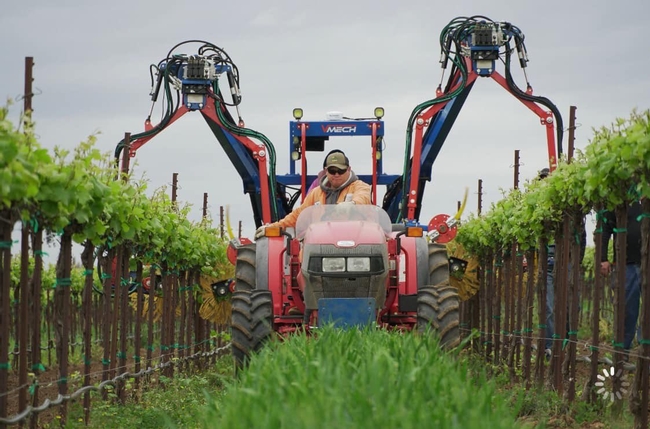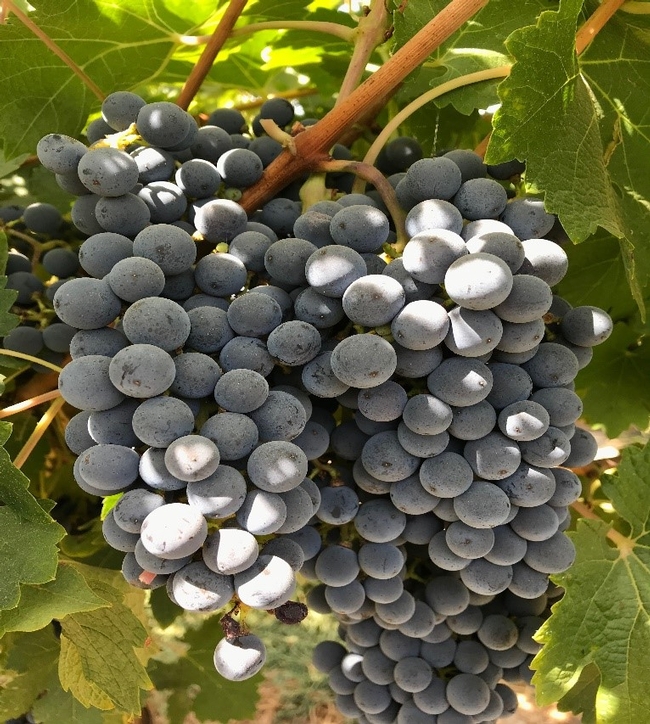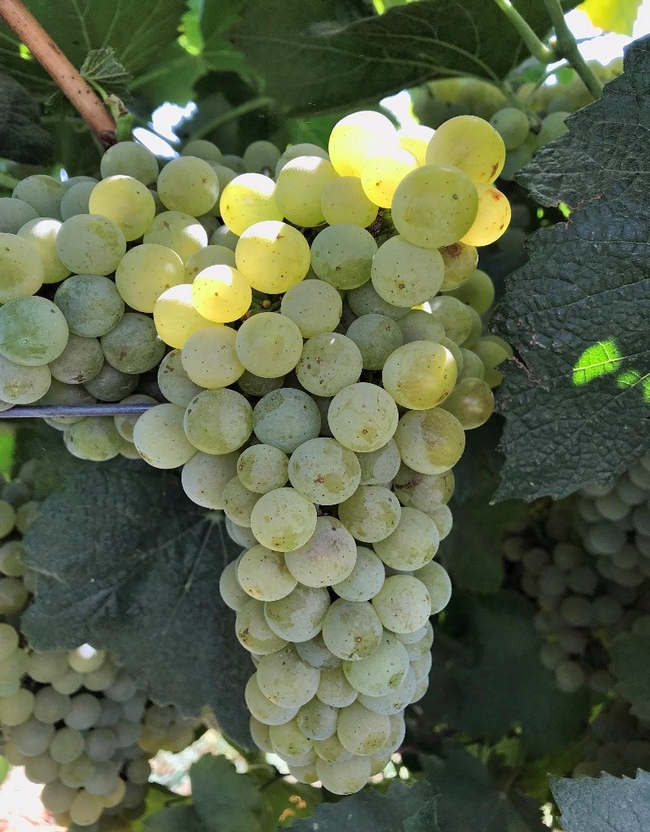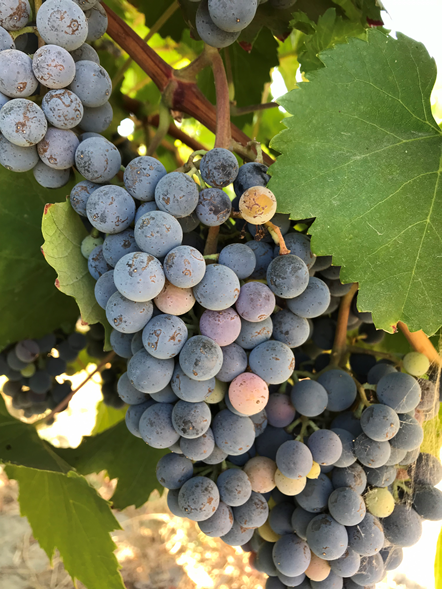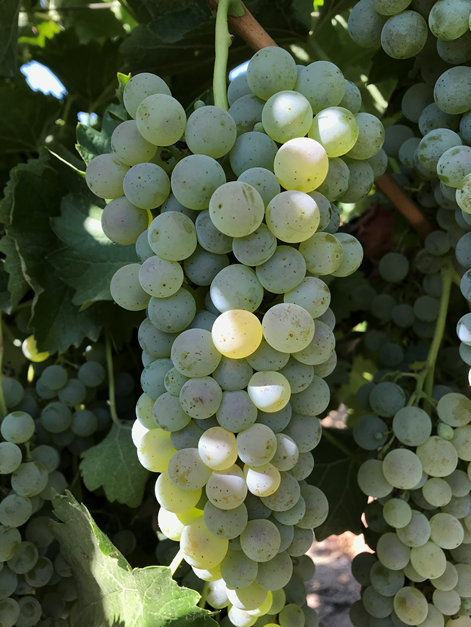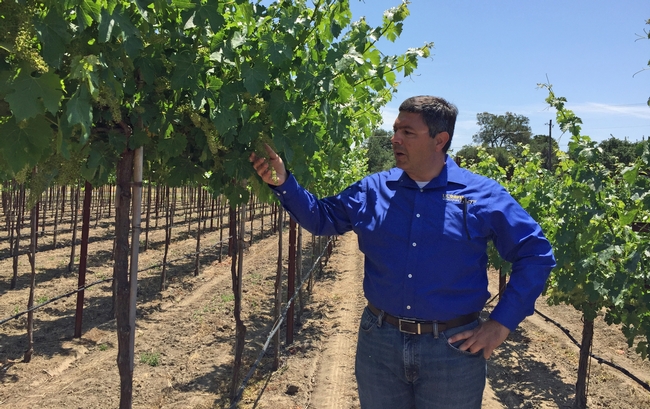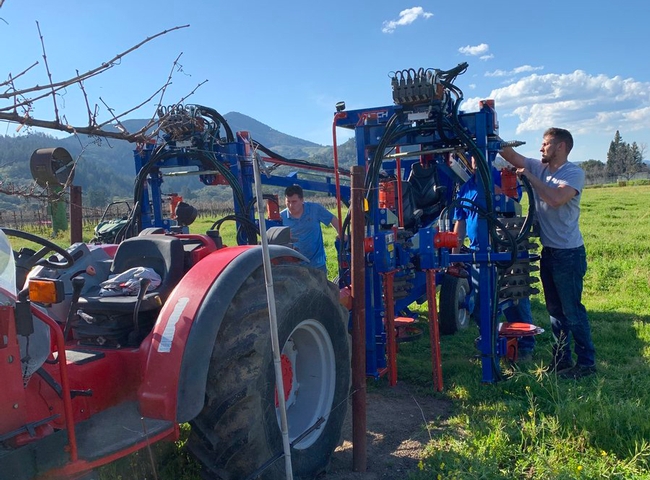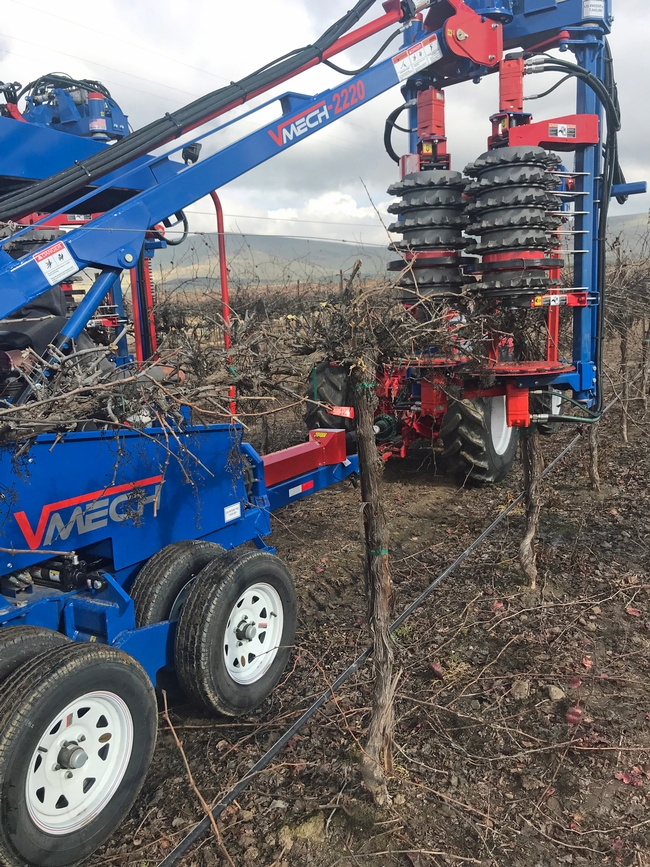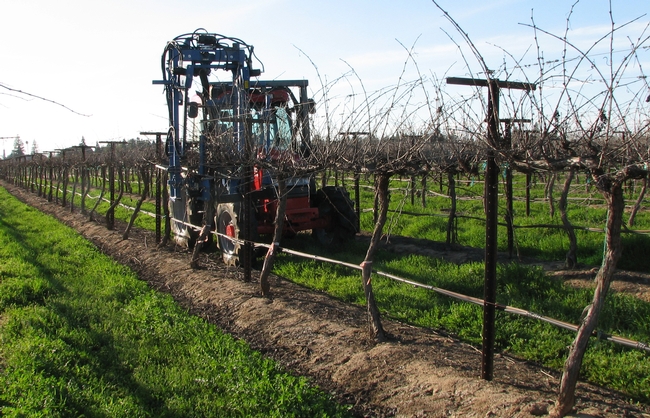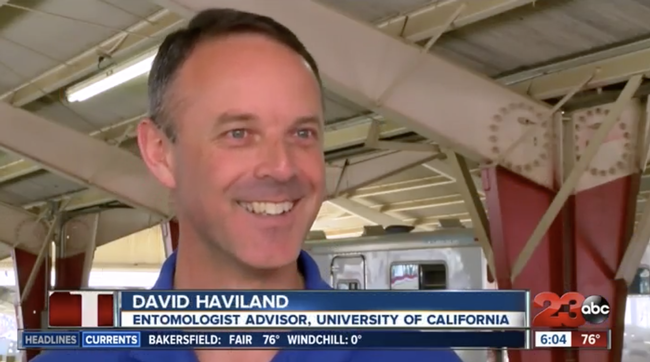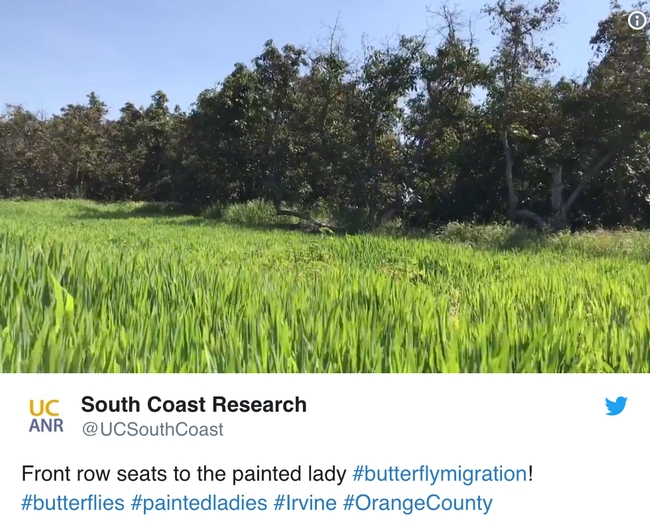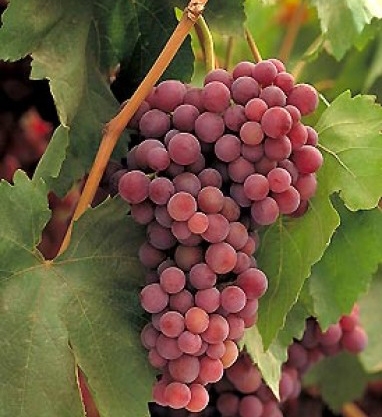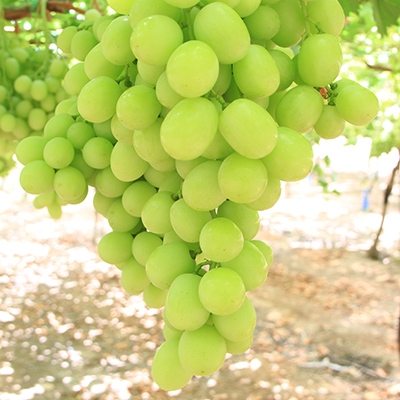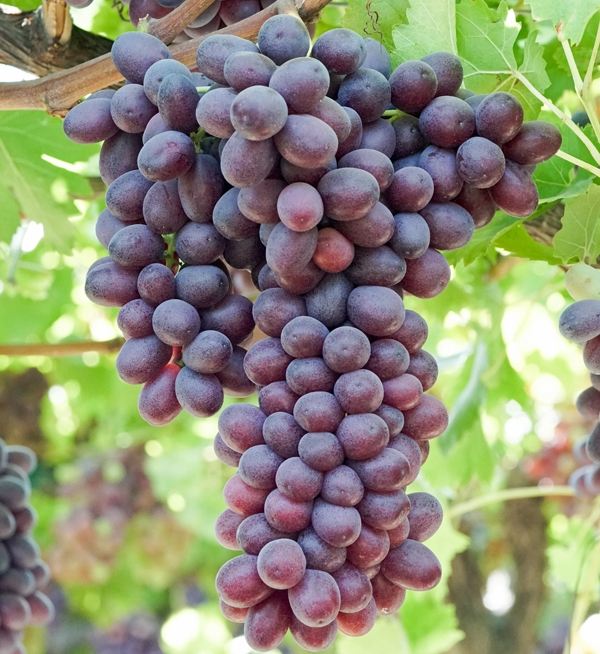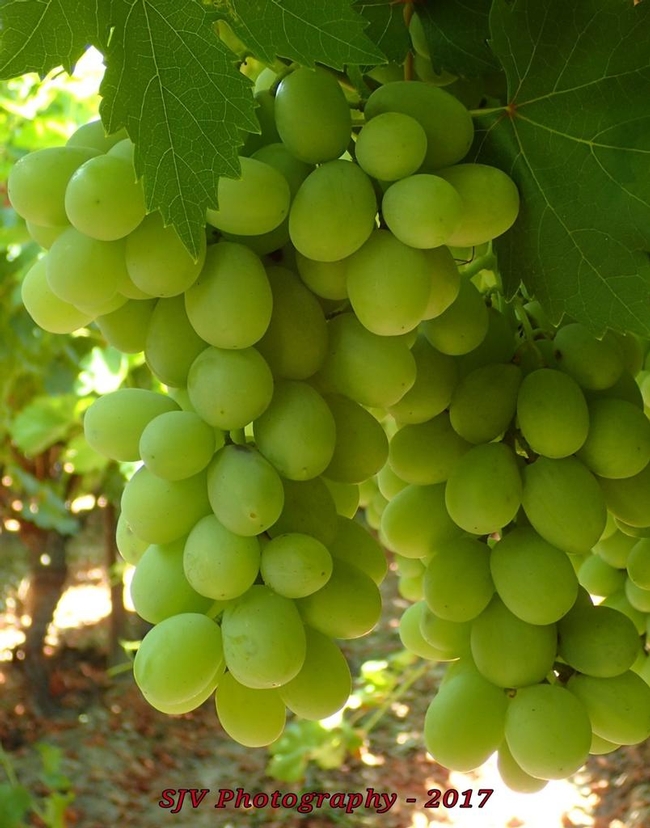Posts Tagged: George Zhuang
UC releases new cost studies for mechanized winegrape production
New studies provide details about trellis type, planting density, cost and potential benefit of vineyard mechanization
UC Agriculture and Natural Resources' Agricultural Issues Center has released four new studies detailing the costs and returns of wine grape production in the southern San Joaquin Valley. All four cost studies illustrate the cost and benefit of nearly full mechanization on wine grape production.
The studies estimate the cost of establishing a vineyard and producing wine grapes, focusing on four wine grape varieties – Cabernet Sauvignon, Chardonnay, Rubired and Colombard.
“Those studies take into consideration mechanical pruning, leafing, shoot thinning, and harvest on a typical wine grape vineyard with the average production level for this region,” said George Zhuang, UC Cooperative Extension viticulture advisor in Fresno County.
“With farming labor becoming more scarce and expensive, growers will opt to transition into more mechanization,” Zhuang said. “These studies provide detailed information about the trellis type, planting density, cost and potential benefit of vineyard mechanization. Based on these studies, fully implemented mechanization reduces the production cost from $3,000 to $2,500 per acre and that represents 17% cost reduction. This information will ultimately help growers to guide their production practices to more profitable and competitive ways under the new era of farming labor.”
Wine grape growers should look at the costs, particularly expenses associated with mechanization, Zhuang said.
“The investment to purchase and own equipment can be high,” Zhuang said. “Fortunately, it is easy to find a contractor in this region to perform certain vineyard tasks, if the initial investment to purchase equipment is prohibitive.”
Numerous studies, including UC studies, have confirmed the benefits of vineyard mechanization to grape and wine quality with lower production costs.
“It is a win-win-win situation,” Zhuang said. “Growers can improve their farming margins, wineries and juice processing plants can get reliable and higher quality grapes and juice from farms, and average consumers can enjoy better wine and more healthy grape products at an affordable price.”
The studies are based on 200-acre farms with the vineyard established on 40 acres using two types of trellis systems – quadrilateral cordon system and bilateral cordon system. In addition to regular grape production expenses – such as irrigation, fertilization and pest control – the researchers broke out the differences between machinery costs and hand labor hours required for thinning, pruning and harvesting for each variety.The prices for labor, materials, equipment and custom services are based on October 2019 figures.
The California minimum wage law will gradually decrease the number of hours employees can work on a daily and weekly basis before overtime wages are required. For more information and to view the California minimum wage and overtime phase-in schedules visit aic.ucdavis.edu.
Input and reviews were provided by UC Cooperative Extension farm advisors, specialists, grower cooperators and other agricultural associates. The authors describe the assumptions used to identify current costs for wine grape establishment and production, material inputs, cash and non-cash overhead. A ranging analysis table shows profits over a range of prices and yields.
The new studies are:
- 2019 - Sample Costs to Establish and Produce Winegrapes in the Southern San Joaquin Valley – Chardonnay Variety
- 2019 - Sample Costs to Establish and Produce Winegrapes in the Southern San Joaquin Valley –Cabernet Sauvignon Variety
- 2019 - Sample Costs to Establish and Produce Winegrapes in the Southern San Joaquin Valley – Rubired Variety
- 2019 - Sample Costs to Establish and Produce Winegrapes in the Southern San Joaquin Valley – Colombard Variety
All four winegrape studies can be downloaded from the UC Davis Department of Agricultural and Resource Economics website at http://coststudies.ucdavis.edu. Sample cost of production studies for many other commodities are also available on the website.
For additional information or an explanation of the calculations used in the studies, contact Donald Stewart at the Agricultural Issues Center at (530) 752-4651 or destewart@ucdavis.edu.
For information about local grape production, contact George Zhuang, UCCE viticulture advisor for Fresno County, at gzhuang@ucanr.edu; UCCE viticulture specialist Matt Fidelibus at mwfidelibus@ucanr.edu; UCCE viticulture specialist Kaan Kurtural at skkurtural@ucdavis.edu; Karl Lund, UCCE viticulture advisor for Madera, Merced and Mariposa counties, at ktlund@ucanr.edu; or Gabriel Torres, UCCE viticulture advisor for Kings and Tulare counties, at gabtorres@ucanr.edu.
The winegrape industry is well suited to mechanized production
A major expense in producing winegrapes is labor. Two UC Cooperative Extension experts appeared on the Jefferson Exchange radio program to explain how mechanization of pruning, leaf removal and shoot thinning, combined with mechanized harvesting widely implemented decades ago, will dramatically reduce the need for labor in California winegrape production.
"The minimum wage is going to increase to $15 per hour in 2022," said George Zhuang, viticulture advisor with UCCE Fresno County. Besides, it is getting more challenging for growers to find enough workers due to labor shortages and higher wages in other fields, such as construction.
The machinery for mechanized vineyards requires an investment of about $100,000, said Kaan Kurtural, UCCE viticulture specialist. At that cost, growers begin to break even after a year.
The biggest obstacle to mechanization is the way winegrape vineyards have traditionally been trellised. The cross arms get in the way of machines as they go through the vineyards. In a recent research project by Zhuang and Kurtural, the scientists converted a traditional system to single high wire and managed it with mechanical equipment.
"It was more profitable ... with the same, if not better, quality and value at the farm gate," Kurtural said. "The writing is on the wall for growers to adapt to this as quickly as possible."
Host Geoffrey Riley asked whether the labor savings will result in cheaper wine. Kurtural laughed.
"No," he said. "Wine prices are set by market demand. I don't think wine is an expensive beverage."
Winegrape vineyards can be converted for machine pruning without replanting
Wine grape growers in the San Joaquin Valley who want to switch from hand pruning to mechanical pruning won't have to replant their vineyards to accommodate machinery, according to a new study published in HortTechnology by University of California Cooperative Extension researchers. Instead, growers can retrain the vines to make the transition, without losing fruit yield or quality.
Mechanical pruning reduced labor costs by 90%, resulted in increased grape yields and had no impact on the grape berry's anthocyanin content. That's welcome news for growers because the cost of re-establishing a vineyard in the region is roughly $15,600 per acre.
“We found that growers do not have to plant a new vineyard to mechanize their operations,” said Kaan Kurtural, UC Cooperative Extension specialist in the UC Davis Department of Viticulture and Enology. “We have proven beyond a doubt that an older vineyard can be converted to mechanization. There is no loss in yield during conversion and post-conversion yield is better and fruit quality is equivalent to or better than hand-managed vines. The economies of scale are evident in the savings per acre and per vine as depicted in the balance sheet provided with the newly published paper.”
The research was conducted in an 8-acre portion of a 53-acre, 20-year-old Merlot vineyard in Madera County. After completion of the research project, the grower converted the rest of the 53-acre vineyard to single high-wire sprawling system. Many other wine grape growers have followed suit.
The Wine Group, which manages 13,000 acres of vineyards across Central California, is establishing new vineyards and converting old vineyards for mechanical pruning and suckering, said vineyard manager Nick Davis. Davis, who works closely with Kurtural and the UCCE viticulture advisor in Fresno County, George Zhuang, said the company greatly values the UC Cooperative Extension research that is guiding the changes.
“I think extensionists are undervalued,” Davis said. “We lean on them for applied research, which has been wonderful. They offer us what we can't provide ourselves.”
More than half of all California wine grapes are grown in the San Joaquin Valley. Worker shortages, rising labor costs, low returns and occasional droughts are driving wine grape growers to seek innovative ways to sustain their businesses.
“To help growers maintain the profitability of their vineyards, we're studying the use of machines to reduce the number of people needed to perform tasks like pruning,” Zhuang said.
“Because the canopy architecture and yield characteristics of mechanically pruned vines are different from vines that are hand-pruned, the water and fertilizer requirements for the mechanically pruned vines can be quite different. So we are studying the yield and fruit quality of grapes produced on different rootstocks in mechanical pruning systems in the San Joaquin Valley,” Zhuang said.
The Madera field study was conducted for three consecutive seasons in the hot climate conditions typical of the San Joaquin Valley. In this area, traditional vineyards are head-trained to a 38-inch-tall trunk above the vineyard floor and two eight-node canes are laid on a catch wire in opposite directions and two eight-node canes are attached to a 66-inch high catch wire. Although this traditional training system can work for mechanical harvesting, it doesn't accommodate mechanical dormant pruning and shoot removal with limited success in other mechanical canopy management operations.
To accommodate mechanical pruning and shoot removal, the vines were converted to a bilateral cordon-trained, spur-pruned California sprawl training system, or to a bilateral cordon-trained, mechanically box-pruned single high-wire sprawling system.
The latter option proved to be the most successful system for mechanical pruning in the San Joaquin Valley.
ANR in the news March 13-28
New Series of Nitrogen Management Advice Available
(Cal Ag Today) March 28
California growers can download a new series of publications summarizing efficient nitrogen management practices from UC Agriculture and Natural Resources. The publications are designed to assist growers in complying with state regulations for tracking and reporting nitrogen fertilizer applied to crops, in an effort to prevent nitrogen from leaching into groundwater.
https://californiaagtoday.com/new-series-of-nitrogen-management-advice-available
UC helps growers comply with new regulations
(Farm Press) Tim Hearden, March 27
A few months ago, while I was working with Todd Fitchette on a special package we were doing (or, he was doing and I was pitching in on) that focused on the 50th anniversary of the Citrus Research Board, I wrote a column about the benefits of land-grant universities such as the University of California (UC).
It's not an overstatement, I wrote, that the vast network of UC Cooperative Extension offices and research facilities has enabled agriculture in the Golden State to survive amid daunting challenges.
https://www.farmprogress.com/commentary/uc-helps-growers-comply-new-regulations
Communities come together to reforest Middletown Trailside Park
(Record Bee) Lucy Llewellyn Byard, March 27
Outdoorsman Greg Gusti, a University of California cooperative extension director emeritus who specializes in forests and wild lands ecology, addressed the crowd and gave them instructions on how to plant the trees 20 feet apart; showed them what 20 feet looked like on a tape measure, told them to plant the green side up and to keep the roots straight.
… Students dug in groups, sharing shovels and gloves. Sofie Hall and Elissa Holyoke worked with Michael Jones, a UC Cooperative Extension Forestry Advisor to plant their saplings.
The science and politics of genetically engineered salmon: 5 questions answered
(The Conversation) Alison Van Eenennaam, March 27
A Massachusetts-based company earlier this month cleared the last regulatory hurdle from the Food and Drug Administration to sell genetically engineered salmon in the U.S. Animal genomics expert Alison Van Eenennaam, who served on an advisory committee to the FDA to evaluate the AquAdvantage salmon, explains the significance of the FDA's move and why some have criticized its decision.
https://www.sfchronicle.com/news/article/The-science-and-politics-of-genetically-13719679.php
Students learn about insects at Farm Day in the City
(ABC 23) Amanda Mason, March 26
"Every single insect plays a role, even if it's only purpose is to get eaten by something. Everything is important," said Haviland.
David Haviland an entomologist at the University of California's Extension who studies insects and helps farmers manage agricultural pests, spent Tuesday at the Kern County Fairgrounds teaching students about good bugs and bad bugs at Farm Day in the City.
https://www.turnto23.com/homepage-showcase/students-learn-about-insects-at-farm-day-in-the-city
Expert: Speak up now about agriculture's carbon footprint
(Leader Telegram) Brooke Bechen, March 25
Dr. Frank Mitloehner, a professor and air quality extension specialist in the Department of Animal Science at the University of California-Davis, isn't afraid to speak up, particularly on Twitter where he writes under the handle @GHGGuru. He sees 2.5 million people visiting his Twitter account each month, which provides accurate information on air emissions and busts myths distributed by those looking to attack animal agriculture.
“Being in California is like being at Ground Zero,” he said. “There are urban centers of people who think they're food experts, but most of these people have never set foot on a farm and don't know anything about agriculture.
Wildfire Speaker Series Tonight: Fire Resistant Homes & Defensible Space
(YubaNet) March 25
…Dr. Kate Wilkin is the new Forest and Fire Adviser with UC Cooperative Extension in Butte, Nevada, Sutter, and Yuba Counties. She recently moved here from Berkeley, CA where she was postdoctoral researcher focused on wildfire emissions and fire-forest-water relations. Her PhD, also at UC Berkeley, focused on the efficacy of fuel treatments in Northern California shrublands to reduce fire hazards and on mixed conifer forest-fire-water and fire-biodiversity relations. Before moving to California, Kate grew up in rural Appalachia and then explored other fire-prone regions of the US as a natural resource manager and prescribed fire burner on public and nonprofit lands. Based on these experiences and more, she knows that we need to use solutions responsibly, both old and new, to solve our forest health crisis. Kate will be focusing on incorporating fire safe concepts into residential landscaping.
https://yubanet.com/regional/wildfire-speaker-series-tonight-fire-resistant-homes-defensible-space
UC Cooperative offers water-measurement class
(David Enterprise) March 25
California water rights holders are required by state law to measure and report the water they divert from surface streams. For people who wish to take the water measurements themselves, the University of California Cooperative Extension is offering training to receive certification April 4 in Redding and Woodland.
Costa Mesa designates April as Coyote Awareness Month and approves further informational efforts to manage them
(Los Angeles Times) Luke Money, March 20
…In the past 30 days, about 20 coyote sightings or encounters in Costa Mesa were logged with Coyote Cacher, an online reporting system [created by Niamh Quinn, UCCE advisor, and IGIS].
https://www.latimes.com/socal/daily-pilot/news/tn-dpt-me-cm-coyote-plan-20190320-story.html
UCCE Biologicals Conference Introduces New Crop Protection Tools for Growers
(Vegetables West) Matthew Malcolm, March 19, 2019
Biocontrol agents, beneficial microbes, entomopathogenic fungi and bacteria that can enhance crop production — these were all topics of discussion at the recent UC Cooperative Extension Ag Innovations Conference in Santa Maria, led by UCCE Entomology & Biologicals Advisor Surendra Dara. Watch this brief interview with Surendra as he shares more about what was discussed.
Landowners aim to fight fire with fire
(Benito Link) Blaire Strohn, March 19, 2019
The 2018 wildfire season in California was devastating, which left local landowners to consider how future blazes can be prevented. Their solution: more fire.
On March 14, The San Benito Working Landscapes Group and the UC Cooperative Extension (UCCE) hosted a meeting to discuss prescribed burning on San Benito County rangelands.
…UCCE livestock and natural resources advisor Devii Rao said the meeting also looked at Cal Fire funding and prescribed burn associations. She mentioned that last year former Gov. Jerry Brown signed two pieces of legislation related to prescribed burning:
Senate Bill 901 provides Cal Fire $1 billion for forest health, fuel load, and prescribed burns over five years, including $35 million a year for prescribed fire and other reduction projects.
Senate Bill 1260 requires Cal Fire to collaborate with public and private landowners on prescribed burns. They must also create a program for pre-certification for a “burn boss,” a private contractor that has experience in prescribed burning.
…In June, Rao will co-host a meeting with Lenya Quinn-Davidson and Jeff Stackhouse from UCCE Humboldt County. The meeting is expected to focus on how to develop a prescribed burn association, in addition to a small burn demonstration on a local private ranch.
https://benitolink.com/news/landowners-aim-fight-fire-fire
A More Humane Livestock Industry, Brought to You By Crispr
(Wired) Gregory Barber, March 19
Hopes were running high for cow 401, and cow 401 serenely bore the weight of expectations. She entered the cattle chute obligingly, and as the vet searched her uterus, making full use of the plastic glove that covered his arm up to his shoulder, she uttered nary a moo. A week ago, Cow 401 and four other members of her experimental herd at UC Davis were in the early stages of pregnancy. But now, following a string of disappointing checkups, it was all down to her. Alison Van Eenennaam, the animal geneticist in charge of the proceedings, kept watch from off to one side, galoshes firmly planted in the damp manure, eyes fixed on a portable ultrasound monitor. After a few moments, the vet delivered his fifth and final diagnosis. “She's not pregnant,” he said. Van Eenennaam looked up. “Ah, shit,” she muttered.
https://www.wired.com/story/crispr-gene-editing-humane-livestock
Climate change is hurting migrating waterbirds across the West. It could get worse
(Sacramento Bee) Andrew Sheeler, March 18
…Some birds, like the black-necked stilt and the sandhill crane, which breed early in the season, have thrived in the warming climate, said Mohammad Safeeq, a hydrologist with the Sierra Nevada Research Institute and an adjunct professor at UC Merced.
But others suffer. That includes the killdeer, the Wilson's snipe, the black tern, and the western and Clark's grebe.
“We have looked at 14 species and among eight open-water and shoreline foraging species that have undergone significant population declines, five were negatively associated with temperature increases,” Safeeq said in an email interview.
https://www.sacbee.com/news/local/environment/article227983859.html
Group seeks healthy, resilient forests and communities
(Plumas News) March 18
…A public workshop was held at the Quincy Library on Jan. 15th. Presenter Jeff Stackhouse, the Livestock and Natural Resources advisor for the U.C. Cooperative Extension in Humboldt, presents case studies from the prescribed burn association.
http://www.plumasnews.com/group-seeks-healthy-resilient-forests-and-communities
US researchers moving abroad to avoid FDA's CRISPR-edited animal regulations
(Genetic Literacy Project) Cameron English, Alison Van Eenennaam, March 14
One day soon, farmers may be able to raise food animals immune to deadly diseases and spare them painful but necessary procedures like horn removal. These innovations, made possible by CRISPR and other gene-editing techniques, could cut the cost of food production, reduce antibiotic use in agriculture and dramatically improve animal welfare. But federal regulation may very well stifle these developments in the US.
In 2017, the Food and Drug Administration (FDA) proposed a plan to regulate gene-edited animals as veterinary drugs under the 1938 Food, Drug and Cosmetic Act, because their DNA is “intentionally altered.” The proposal has drawn harsh criticism from animal scientists, some of whom are packing up their labs and leaving the US to avoid the FDA's rules. Food animals, these experts say, should be regulated based on the risk they pose to human health, not the breeding method that produced them.
Corky Anderson's energy, innovation helped save California's pistachio industry
(Bakersfield Californian) Steven E. Mayer, March 13
"Corky was an important player in the early pistachio industry," said a Kern County farm adviser with the UC Cooperative Extension who specializes in citrus and pistachios.
"And he was a great cooperator," Kallsen said. "He allowed lots of test trials on his properties."
… In 1980, Anderson and Puryear's first patented rootstock changed the industry, said Kevin Blackwell, general manager of Pioneer Nursery, the wholesale business founded by the two entrepreneurs.
"In our heyday, we were selling a million trees a year," said Blackwell, who said he has known Anderson for 47 years.
No one does it alone, Kallsen noted. Anderson built and refined his patented rootstock based on earlier research by the University of California.
Farmers protect crops in rain's aftermath
(Ag Alert) Ching Lee, March 13
Franz Niederholzer, University of California Cooperative Extension farm advisor in Colusa, Sutter and Yuba counties, said though cold weather does reduce the risk of most fungal diseases, other problems such as bacterial blast and jacket rot—also a fungal disease—are more prevalent during cool weather.
Cooler weather, however, does help to extend the bloom, he said. That allows farmers more time to apply fungicide, which is recommended at the beginning of bloom and again at full bloom, he said.
Brent Holtz, UCCE farm advisor in San Joaquin County, said he hasn't seen too many problems with fungal diseases at this point, because of how cool it's been, but there have been more incidents of bacterial blast, which can infect trees under stress. In orchards with high nematode populations, the bacteria can enter wounds on the surface of the plants created by frost, he noted.
"It blights the blossoms, and if the blossom is dead, they don't produce fruit," Holtz said.
http://agalert.com/story/?id=12801
Michael learns about 4-H in Fresno County
(KMPH) Stephen Hawkins, March 13, 2019
The 4-H Youth Development Program is preparing for events all over the Central Valley and you are invited.
Michael Ikahihifo spent the morning at Dry Creek Park in Clovis to see what the local 4-H has planned.
https://kmph.com/great-day/michael-in-the-mix/michael-learns-about-4-h-in-fresno-county
The City of Cypress calls for its residents to be “Coyote Aware”
(OC Breeze) March 13
The Cypress City Council recently adopted a coyote management plan to address community concerns about the presence of coyotes in Cypress. While coyotes are generally reclusive animals who avoid human contact, it is important to be aware of their presence and take appropriate action to ensure the safety of your property and pets.
…Residents are encouraged to reportcoyote activity on Coyote Cacher:
Coyote Cacher allows the City to monitor all reported encounters.
Residents can also use Coyote Cacher to view a map of reported
encounters and sign up to receive email alerts.
California's super bloom attracts swarms of migrating butterflies
(CNN) David Williams, March 13
This year's wildflower super bloom is not only filling California deserts with eye-popping displays of color -- it's also providing a feast for swarms of painted lady butterflies making their way north from Mexico.
"This is the biggest outbreak since 2005," said Art Shapiro, a professor at the University of California, Davis, who's been studying the migration of butterflies in the state since 1972.
…"I saw more butterflies in the last 10 minutes than I've seen my entire life," Jason Suppes wrote Tuesday on Twitter. Suppes is an education specialist at an agricultural research facility in Irvine.
http://edition.cnn.com/travel/article/california-butterflies-trnd/index.html
Grape growers continue push to mechanize
(Western Farm Press) Lee Allen, March 13
…In Fresno, growers affiliated with the San Joaquin Valley Winegrowers Association met to discuss the latest UC research on incidents of disease and machine injury to trunks and rootstock.
… “Growers are having a hard time finding workers to maintain their vineyards and increasing labor costs are challenging grape-farming's economic sustainability,” says UC Cooperative Extension viticulture advisor George Zhuang. “We're studying the use of machines to reduce the number of people needed to perform tasks like pruning.
“Because canopy architecture and yield characteristics involving mechanically-pruned vines are much different from those that are hand-pruned, water and fertilizer requirements for the mechanically pruned vines can be quite different. Performance of different rootstocks in mechanical pruning systems is critical for both yield and fruit quality of grape production in the San Joaquin Valley.”
…Kaan Kurtural, UC Cooperative Extension viticulture specialist in the UC Davis Viticulture and Enology Department, whose research involves improving vineyard production efficiency through canopy and crop load management via mechanization, says the case for switching out hand labor with machines gets stronger with growers using such mechanization for pruning, suckering, and removing shoots and leaves.
“Mechanical pruning can produce more stable year-to-year fruit yields of better quality than traditional and more costly hand pruning spurs or canes.” His comments were based on a Kern County two-year research trial looking for ways for growers to reduce both cost and water use.
https://www.farmprogress.com/grapes/grape-growers-continue-push-mechanize
As Wildfires Devour Communities, Toxic Threats Emerge
(Reuters) Sharon Bernstein, March 13
At U.C. Davis, where researchers are studying eggs from backyard chickens that may have breathed smoke and pecked at ash in areas affected by wildfires, the work is complicated.
"In an urban fire you're dealing with contaminants that don't go away – arsenic, heavy metals, copper, lead, transformer fluid, brake fluid, fire retardant," said veterinarian Maurice Pitesky, who is leading the study.
https://www.usnews.com/news/us/articles/2019-03-13/as-wildfires-devour-communities-toxic-threats-emerge
DR. GLENDA HUMISTON: Managing our Lands to Manage our Water
Maven's Notebook, March 13, 2019
Dr. Glenda Humiston is Vice President of Agriculture & Natural Resources for the University of California. At the 2019 California Irrigation Institute conference, Dr. Humiston was the opening keynote speaker, and in her speech, she talked about work being done to address drought vulnerability, the importance of managing watersheds, the goals of the California Economic Summit, and the promising future of biomass.
She began by saying that we have known for a long time that water insecurity is a huge issue, and not just due to climate change or droughts; it's also policy, regulations, allocations and technology – there are a lot of issues and managing the effects of it are very challenging.
https://mavensnotebook.com/2019/03/13/dr-glenda-humiston-managing-our-lands-to-manage-our-water/
Hearing planned to examine the future of development in California's most fire prone regions
(Lake County News) March 13
…The hearing, led by Senators Henry Stern and Mike McGuire, chair of the Senate Natural Resources and Water Committee and the Senate Governance and Finance Committee, respectively, titled “Living Resiliently in the New Abnormal: The Future of Development in California's Most Fire Prone Regions” will be held Wednesday at 9:30 a.m. at the State Capitol in Room 4203.
…Testifying at the hearing are:
· Mark Ghilarducci, director, California Office of Emergency Services;
· Bob Fenton, regional administrator, FEMA Region 9;
· Dr. Max Moritz, statewide wildfire specialist, University of California Cooperative Extension;
· Jeff Lambert, director of planning, city of Oxnard, past president, American Planning Association, California Chapter;
· Chief Kate Dargan, California State Fire Marshal (retired), Cal Fire;
· Chief Ken Pimlott, director (retired), Cal Fire;
· Scott Lotter, former mayor, city of Paradise;
· Tim Snellings, planning director, Butte County;
· Chief Michael McLaughlin, Cosumnes Community Services District Fire Department;
· Ty Bailey, California Professional Firefighters, president, Sacramento Area Firefighters, Local 522, fire captain, Sacramento Metropolitan Fire District.
New labor laws factored into UC cost studies for table grape production
To help table grape growers make decisions on which varieties to grow, the UC Agriculture and Natural Resources' Agricultural Issues Center has released four new studies on the costs and returns of table grapes in the Southern San Joaquin Valley. The studies on different table grape varieties are each based on a 500-acre farm with vineyard establishment on 40 acres.
The studies focus on four table grape varieties. There are two early maturing varieties, Flame Seedless and Sheegene-21, that begin harvest in July, one mid-season maturing, Scarlet Royal, and one late maturing, Autumn King, which begins harvest in October. The studies estimate the cost of establishing a table grape vineyard and producing fresh market table grapes.
“Labor costs are expected to rise with reduced labor availability, increases in minimum wage rates and new overtime rules that went into effect in 2018,” said Ashraf El-kereamy, UCCE viticulture advisor in Kern County and co-author of the cost studies.
“We included detailed costs for specialized hand labor of certain cultural and harvest operations.”
The sample costs for labor, materials, equipment and custom services are based on January 2018 figures. A blank column, titled “Your Cost,” is provided in Tables 2 and 3 for growers to enter their own estimated costs.
“The new California minimum wage law will gradually decrease the number of hours employees can work on a daily and weekly basis before overtime wages are required. There are additional stipulations for overtime wages and scheduling of work that are part of the new law,” said Daniel Sumner, director of the Agricultural Issues Center.
Input and reviews were provided by UC ANR Cooperative Extension farm advisors, specialists, grower cooperators, California Table Grape Commission and other agricultural associates. The authors describe the assumptions used to identify current costs for table grape establishment and production, material inputs, cash and non-cash overhead. A ranging analysis table shows profits over a range of prices and yields. Other tables show the monthly cash costs, the costs and returns per acre, hourly equipment costs, and the whole farm annual equipment, investment and business overhead costs.
The new studies are:
- “2018 - Sample Costs to Establish and Produce Table Grapes in the Southern San Joaquin Valley – Flame Seedless, Early Maturing”
- “2018 - Sample Costs to Establish and Produce Table Grapes in the Southern San Joaquin Valley – Sheegene-21 (Ivory™), Early Maturing”
- “2018 - Sample Costs to Establish and Produce Table Grapes in the Southern San Joaquin Valley – Scarlet Royal, Mid-season Maturing”
- “2018 - Sample Costs to Establish and Produce Table Grapes in the Southern San Joaquin Valley – Autumn King, Late Maturing”
All four table grape studies can be downloaded from the UC Davis Department of Agricultural and Resource Economics website at http://coststudies.ucdavis.edu. Sample cost of production studies for many other commodities are also available at the website.
For additional information or an explanation of the calculations used in the studies, contact Donald Stewart at the Agricultural Issues Center at (530) 752-4651 or destewart@ucdavis.edu.
For information about local table grape production, contact UC Cooperative Extension viticulture specialist Matthew Fidelibus at mwfidelibus@ucanr.edu, UCCE viticulture advisor Ashraf El-kereamy in Kern County at aelkereamy@ucanr.edu, UCCE entomology advisor David Haviland in Kern County at dhaviland@ucdavis.edu, UCCE weed advisor Kurt Hembree in Fresno County at kjhembree@ucanr.edu, or UCCE viticulture advisor George Zhuang in Fresno County at gzhuang@ucanr.edu.

